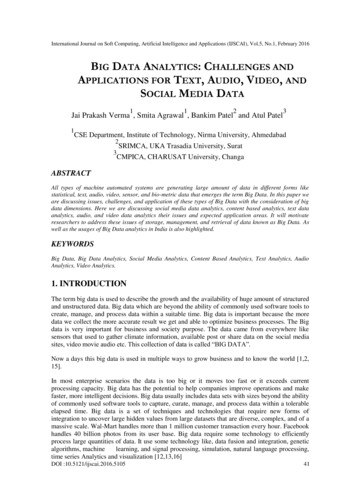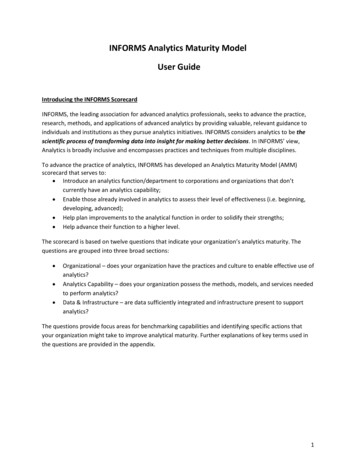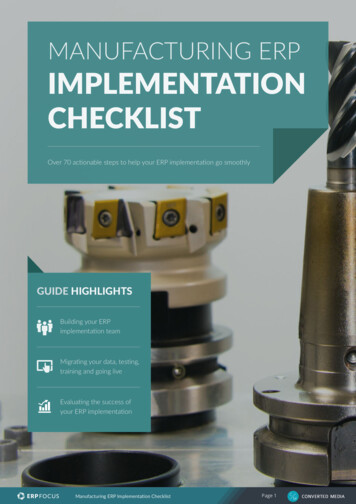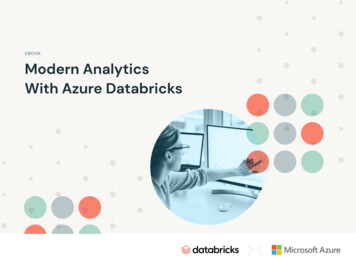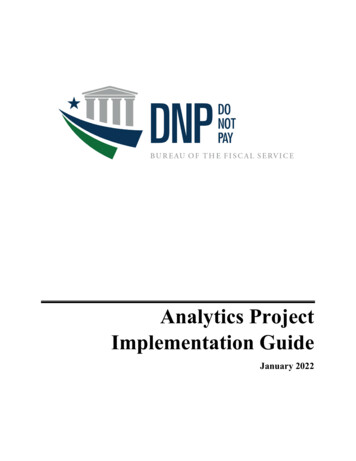
Transcription
Analytics ProjectImplementation GuideJanuary 2022
Table of ContentsSECTION 1: Introduction to Do Not Pay Analytics . 31.1Do Not Pay Background . 31.2Do Not Pay Analytics Services . 31.3What Types of Analyses Does DNP Analytics Provide?. 41.4What Types of Customers Partner with DNP Analytics? . 4SECTION 2: Death Record Confidence Scoring Tool . 5SECTION 3: Data Sources . 73.1Use of Data Sources in Analytics Projects . 73.2Federal Customers. 73.3State Customers . 8SECTION 4: Project Lifecycle . 104.1How to Request a Project from DNP Analytics . 104.2Roles and Responsibilities . 104.3Meetings to Expect . 104.4Governance Process – Customer Acknowledgement Form . 124.5Data Transfer . 134.6Data Needs . 134.7Project Execution . 144.8Feedback . 14SECTION 5: Project Governance . 155.1Federal Customers – Customer Acknowledgement Form . 155.1State Customers – Customer Acknowledgement Form . 16APPENDIX A: Analytics File Transfer . 17A.1Form . 17A.2HTTPS . 17APPENDIX B: Data Source Descriptions . 18B.1Death Data Sources . 18B.2Eligibility and Debarment Data Sources . 19B.3Delinquent Debtor Data Sources. 20B.4Payment Data Sources . 20DNP Analytics Project Implementation GuideLast Updated: January 20222
SECTION 1: Introduction to Do Not Pay Analytics1.1 Do Not Pay BackgroundDo Not Pay (DNP) operates a resource dedicated to assisting federal agencies and federallyfunded, state-administered programs in preventing and detecting improper payments. DNP’sservices are no-cost to agencies and state programs. DNP provides centralized access to avariety of relevant data sources for verifying payment and award eligibility through datamatching in the DNP Portal. DNP also provides customized data analytics services to helpagencies and state programs detect fraud, waste, and abuse.DNP is authorized and governed by the Payment Integrity Information Act of 2019 (PIIA) andseveral Office of Management and Budget (OMB) memoranda and circulars. The Office ofManagement and Budget (OMB) designated the Department of the Treasury to host the WorkingSystem to assist federal agencies in identifying and preventing improper payments. The Bureauof the Fiscal Service (Fiscal Service) operates the DNP Business Center.DNP’s goals are to: provide timely, accurate, and actionable information about payees and payments to assistcustomers in identifying, preventing, and stopping improper paymentsdevelop and assist customers in implementing cutting-edge techniques to protect theintegrity of payments and awardsinnovate and introduce new tools, technologies, and strategies to support customers inidentifying and preventing a wide variety of improper payments1.2 Do Not Pay Analytics ServicesDNP Analytics, part of the DNP Business Center, provides custom analyses to meet customers’business needs. DNP’s analytics services come at no cost to the customer.DNP conducts analytics projects to: identify deceased payees, individuals and vendors who are ineligible to receive federaland state benefitsdetect data quality issues and process improvements in areas where internal controls arenot effectively preventing improper paymentscarry out other custom analyses which are tailored to the customer’s business problemsand business rulesThe DNP Analytics team is comprised of data analysts and data scientists, who are experts incomplex analyses and data wrangling. The analytics team includes analytics consultants whoserve as liaisons between the customer and the project team to ensure that the analysis conductedis exactly aligned to the customer’s expectations. Each analytics project is executed by a teamcomprised of two data analysts/data scientists and an analytics consultant. Analytics projectsconducted by DNP are centered on a customer’s data set. The analytics team uses the customer’sDNP Analytics Project Implementation GuideLast Updated: January 20223
data in conjunction with the data sources available to DNP to generate analytics results andreport actionable findings.1.3 What Types of Analyses Does DNP Analytics Provide?DNP Analytics conducts a variety of projects that are related to the identification of improperpayments. Recent projects have included the following types of analyses: Vendor and individual eligibility verificationDeceased payee analysis (including projects using the Death Record Confidence ScoringTool – see Death Record Confidence Scoring Tool section below)Data quality and integrity checksBusiness risk assessmentPayment accuracyVendor consolidationCross-government analysisAd-hoc analysis and custom analytics research1.4 What Types of Customers Partner with DNP Analytics?DNP Analytics conducts analytics projects for the following entities and initiatives: Federal agenciesFederal oversight groupsFederally funded, state-administered programsState oversight groupsCARES Act initiativesEnterprise customersDNP Analytics Project Implementation GuideLast Updated: January 20224
SECTION 2: Death Record Confidence Scoring ToolThe Death Record Confidence Scoring Tool (DRC Scoring Tool) is a product developed by DNPto help analytics customers prioritize their research efforts and improve their adjudicationprocesses. The DRC Scoring Tool enables DNP to effectively identity deceased individualswithin a dataset, and helps customers understand which payments are most at risk of being issuedto a deceased payee. DNP recommends the DRC Scoring Tool for analytics projects focused onidentifying decedents within a customer’s data. The results are prioritized based on theindividuals most likely to be deceased or that have the highest risk based on dollar value. Thislets customers know which records to review first.The DRC Scoring Tool analyzes all death data available to DNP. DNP uses this analysis todetermine the accuracy of the death information, and account for difference in data qualitybetween the records. The DRC Scoring Tool converts this information into a confidence scorebased on the likelihood the individual is truly deceased. DNP then uses the confidence score, incombination with payment information within the customer’s dataset, to identify the records thathave the greatest potential impact for customers. This helps them reduce the amount of timespent researching and adjudicating records that may have little value.Benefits of the DRC Scoring Tool: Customers gain a better understanding of which individuals within their data may bedeceased based on a confidence score. Potentially improper payments to deceased individuals are uncovered and rank-orderedbased on potential impact to the agency. Customers achieve additional assurance of their payment integrity. Customers benefit from less time spent conducting external research, and increasedefficiency in their adjudication processes.Features of the DRC Scoring Tool: DRC Tool provides information to customers in a user-friendly file that helps themingest, prioritize, and act on the information. The interface has the following keyfeatures:o Payments and the death record matches are grouped together for each payee,rather than listed as individual line items and mixed in with matches against otherpayeeso Interactivity to allow users to quickly navigate through the tool and extractinformationo Research priority of each payee based on the likelihood of death, strength of thematch, dollars at risk, and how soon the next payment is anticipatedo Probability of death and the accuracy of the match (death and match confidence)DNP Analytics Project Implementation GuideLast Updated: January 20225
o Estimated disbursement date of the next anticipated payment to aid in determininghow urgently adjudicating and potentially stopping the payment should beaddressedo Number and value of at-risk paymentso Date a second death source listed the individual as deceasedDNP Analytics Project Implementation GuideLast Updated: January 20226
SECTION 3: Data Sources3.1 Use of Data Sources in Analytics ProjectsDNP’s analytics projects use a wide range of data sources to meet customers’ needs. The datasources available to DNP include information on death, payment recipient eligibility, debarment,delinquent federal debts, and payment information. DNP leverages the information within thesedata sources in combination with the data provided by the customer to identify improperpayments and other project goals. Many of the data sources available to DNP provide anindication of a payment recipient’s eligibility. For example, if a payment recipient was identifiedon a data source as “deceased,” then a payment made to that individual is potentially improper.DNP also uses the information in the available data to conduct a variety of other types ofanalyses for customers such as business risk assessments, cross-government analysis, andnetwork analysis.3.2 Federal CustomersBelow are the data sources currently offered for inclusion in DNP Analytics projects with federalcustomers. (For a detailed description of each data source, see Appendix B.)Death Data Sources Death Master File (DMF), Public American InfoSource (AIS) – Probate American InfoSource (AIS) ‒ Obituary Department of Defense Death Data (DoD) Department of State Death Data (DoS) Payments, Claims, and Enhanced Reconciliation (PACER) Death DataEligibility Data Sources System for Award Management (SAM) Entity Registration Records, Public System for Award Management (SAM) Entity Registration Records, Restricted IRS Tax Exempt Organization Searcho Publication 78 (PUB78)o Automatic Revocation List (ARL)o 990-N (e-Postcard)Debarment Data Sources System for Award Management (SAM) Exclusion Records, Public System for Award Management (SAM) Exclusion Records, Restricted List of Excluded Individual and Entities (LEIE), Public List of Excluded Individual and Entities (LEIE), Restricted Office of Foreign Assets Control (OFAC)DNP Analytics Project Implementation GuideLast Updated: January 20227
Delinquent Debtor Data Sources Treasury Offset Program (TOP) Debt Check, Restricted Credit Alert System (CAIVRS)Input from:o Veterans Affairs (VA)o Small Business Administration (SBA)o Housing and Urban Development (HUD)o Department of Justice (DOJ)o U.S. Department of Agriculture (USDA)Payment Data Sources Payment Automation Manager (PAM), Payment Data Payments, Claims, and Enhanced Reconciliation (PACER), Payment Data3.3 State CustomersBelow are the sources currently offered for inclusion in state customer DNP Analytics projects.(For a description of each source, please see Appendix B.)Death Data Sources American InfoSource (AIS) – Probate American InfoSource (AIS) ‒ Obituary Death Master File (DMF), Public Department of Defense Death Data (DoD) Department of State Death Data (DoS)Eligibility Data Sources System for Award Management (SAM) Entity Registration Records, Public IRS Tax Exempt Organization Searcho Publication 78 (PUB78)o Automatic Revocation List (ARL)o 990-N (e-Postcard)Debarment Data Sources System for Award Management (SAM) Exclusion Records, Public List of Excluded Individual and Entities (LEIE), Public List of Excluded Individual and Entities (LEIE), Restricted Office of Foreign Assets Control (OFAC)DNP Analytics Project Implementation GuideLast Updated: January 20228
Delinquent Debtor Data Sources Credit Alert System (CAIVRS)Input from:o Small Business Administration (SBA)o Housing and Urban Development (HUD)o U.S. Department of Agriculture (USDA)DNP Analytics Project Implementation GuideLast Updated: January 20229
SECTION 4: Project Lifecycle4.1 How to Request a Project from DNP AnalyticsTo engage in an analytics project with DNP Analytics, please contact your Agency Lead/AgencySpecialist, the Do Not Pay Agency Support Center at 855-837-4391, or email the Do Not PayMailbox at donotpay@fiscal.treasury.gov.4.2 Roles and ResponsibilitiesUndertaking an analytics projects requires committed action from both the customer and DNP.The success of an analytics project depends on the follow-through of DNP and the customer tomeet their respective responsibilities.The roles and responsibilities of DNP Analytics during a project engagement include: Creating the governance form that is required to engage in the requested analysesGetting internal legal, privacy, and leadership approval for the formGuiding the customer through the data intake and data transfer processesMeeting with the customer to discuss any business rule or data questionsExecuting the analysis, delivery of project resultsFollowing up with the customer to ensure the full understanding of the project’s resultsand to address all questions regarding the analysesThe roles and responsibilities of the customer during a project engagement include: Providing DNP Analytics comprehensive understanding of the background of theanalytics project request as well as any applicable business rulesApproving the governance form with all applicable internal partiesProviding required information/testing to establish a secure data transfer connectionProviding all necessary data to DNP AnalyticsAnswering questions from DNP that may arise about the data or business processeswhile the project team is in executionProviding feedback on the final deliverable and project results within 120 days of projectdelivery4.3 Meetings to ExpectAnalytics projects include several meetings between the customer and DNP, from project intaketo project feedback. Outlined below is a list of the different types of meetings that can occurover the course of an analytics project engagement with DNP.DNP Analytics Project Implementation GuideLast Updated: January 202210
Project Intake:o Purpose – to familiarize the project requestor with DNP Analytics, provide anoverview of our analytics capabilities, and to determine whether a DNP Analyticsproject can assist the requestor with their business problem.o Customer participants to include – personnel who will be using the results, andpersonnel in a leadership role who will be approving the project under discussion. Project Scoping:o Purpose – to further understand the customer’s business problems, business rules,and the determine the type of analysis needed.o Customer participants to include – personnel who will be using the results,personnel in leadership role who will be approving of the project taking place, anddata experts. Data Needs:o Purpose – to understand the customer’s data that will be used for the analyticsproject, including any nuances of the data. During this meeting critical dataelements necessary for the analysis are identified and discussed. Additionally, theinstructions for the data transfer are provided at this meeting.o Customer participants to include – personnel who are experts in the dataset whichwill be used, personnel who will be accessing the data transfer connection andtransferring the required data to DNP, and personnel who will be using the resultsof the analysis. Project Kick-off:o Purpose – to allow the analytics team executing the project to ask any initialquestions that have arisen during project preparations. This meeting also providesthe customer with an idea of the final deliverable.o Customer participants to include – personnel who will be using the project’sresults and data experts. Project Touch-bases:o Purpose – to meet on a set cadence throughout project execution to verify that theproject team is on the right track and to allow the team to ask the customer anyquestions that may have come up during project execution. The meeting cadencewill be set at the beginning of project execution and will be agreed upon betweenDNP Analytics and the customer.o Customer participants to include – personnel who will be using the results that wesend and data experts.DNP Analytics Project Implementation GuideLast Updated: January 202211
Project Delivery:o Purpose – to allow DNP Analytics to present the final analysis to the customerand to answer any initial questions that the customer may have about the analysisor its findings.o Customer participants to include – personnel who will be using the results,personnel in a leadership role who may be involved with any business changes asa result of the analysis, and data experts. Project Feedback:o Purpose – to allow DNP Analytics to talk to the customer about the projectfeedback. This discussion may include how the analysis has influenced theirbusiness processes, as well as the volume of improper payments that the analysishelped identify and/or stop.o Customer participants to include – personnel who will be using the results that wesend.4.4 Governance Process – Customer Acknowledgement FormDNP analytics projects must abide by a governance process that is aligned with the privacy andlegal considerations associated with matching to and sending a customer’s data. A governanceform called the Customer Acknowledgement Form is drafted by DNP for each analytics project.A project’s governance form serves as a project authorization document and provides specificinformation about the proposed analytics project including project description, data sourcesmatched to, how the project results and data will be used, and other essential information aboutthe analytics project. The governance form is different for federal partners vs. state partners (seeGovernance section below for examples). DNP Governance Signatories:o DNP Senior Managero DNP Legal Counselo DNP Privacy Counselo DNP Outreach Managero DNP Directoro Payment Management Director/other Payment Management signatory (ifapplicable)o CAIVRS/TOP approval (if those data sources are included in the scope of theanalytics project)After the Customer Acknowledgement Form is approved by all applicable internal parties, it issent to the partnering agency or state for digital signature. The document must be signed by thecustomer prior to the project starting and data being shared. The agency or state can appointtheir own signatory, with the expectation that the individual signing the acknowledgment formhas proper authority and has consulted relevant legal and privacy authorities within theirorganization.DNP Analytics Project Implementation GuideLast Updated: January 202212
4.5 Data TransferBefore the project commences, DNP Analytics will meet with the partnering organization for adata call to better understand the customer’s dataset. During this call, DNP will: walk through the steps for setting up a secure data transfer connectiongive details on file specificationsdiscuss data fields preferred for the analysisAny personnel who will be extracting the data and/or transferring the data to DNP, and any dataexperts who can answer questions about the requested data should be included in this call.Once the governance form has been approved by all DNP signatories and the customer, thecustomer’s dataset may be transferred to DNP. The most common method DNP Analytics usesto receive data and send completed analyses is through a secure Hypertext Transfer ProtocolSecure (HTTPS) connection. To begin the process of setting up an HTTPS connection, thecustomer will fill out an Analytics File Transfer Form (see appendix A). Once this form iscompleted and submitted, DNP’s Project Manager will contact the partnering organization torequest the required information for setting up the HTTPS connection. The requestedinformation should not be given through email and needs to be given via a telephone call.The following information is required for each person who will need access to the HTTPSconnection: Full NameIP AddressPhone NumberEmail AddressOnce this information is given to DNP’s Project Manager, the HTTPS connection will be createdfor the customer.4.6 Data NeedsBelow are the preferred file specifications for DNP Analytics. Adhering to these specificationsallows for a quicker data loading and cleaning process. However, not being able to provide datain the requested format is not prohibitive to engaging in a project with DNP Analytics.When submitting data, DNP Analytics requests that partnering organizations: submit their data in a CSV Pipe Delimited file under 2GB in sizedo not submit non-ASCII charactersprepare and submit a data dictionary with their data file, which includes field names, adefinition for each field, the data type of each field, and any other pertinent informationabout the data fileDNP Analytics Project Implementation GuideLast Updated: January 202213
The project team needs several days with the data to allow time to load, clean, format, andfamiliarize themselves with the data. Due to this, data should be sent to DNP at least a weekprior to the project execution start date. This date will be communicated to the customer oncethe Customer Acknowledgement Form is signed by all parties and the project has been scheduledon the DNP Analytics Roadmap.4.7 Project ExecutionOnce the Customer Acknowledgement Form has been approved by internal DNP signatories andthe customer, the project will be put on DNP’s backlog and put on the roadmap for kick-off withthe next available project team. DNP Analytics works in an Agile format, which is comprised oftwo-week sprints. At the project kick-off meeting, DNP Analytics will provide an estimatedproject completion date based on how many sprints the project is expected to take. This estimateis subject to change. If the estimated time is extended or shortened, DNP will notify thecustomer of this change.DNP Analytics will meet with the partnering organization throughout project execution fortouch-base meetings to make sure the project is on track and to ask any questions that come upduring execution. The customer’s data experts who can answer any data-related questions andprogram personnel who are able to answer questions about business rules related to the programare both helpful participants in these touch-base meetings.Once the project is completed, the deliverable and results will be uploaded to the HTTPS andDNP Analytics will notify the customer when results are available. After the analysis has beenreceived by the partnering organization, DNP will schedule a project delivery meeting to discussthe results of the analysis and answer any questions the customer has.4.8 FeedbackAfter project delivery, DNP Analytics requests that the customer provide feedback on theanalytics project results and deliverable within 120 days of results delivery. This feedback iscritical and enables DNP to improve future analyses and better understand the customer’sbusiness processes and rules.Some key metrics that DNP Analytics would like feedback on include but are not limited to: the actual or projected number and dollar amount of improper payments identified and/orpreventedcosts avoided or projected to be avoided through process improvements or other resultsof the analytics project (including savings from centralizing processes by the decision toaccess the DNP Portal)other direct or indirect benefits flowing from the projectThe timeframe for providing feedback can be extended by mutual written agreement of DNP andthe customer.DNP Analytics Project Implementation GuideLast Updated: January 202214
SECTION 5: Project Governance5.1 Federal Customers – Customer Acknowledgement FormThe Customer Acknowledgment Form for federal customers will include: a high-level description of the purpose of the work to be carried outa description of the project deliverable(s) which will be provided at project completion,including what types of analyses DNP will performa description of the privacy implications related to the project and possible limitations onhow the results can be legally useda description of the feedback policy, which states that the customer will provide feedbackwithin 120 days of delivery of the results in order to maintain access to DNP DataAnalytic Servicesa list of all data sources that will be used to match against customer data, and an approvalsection that spells out any data source agreements discussed with DNPa section that notes the System of Records Notice (SORN) that covers the data that willbe in the project engagemento for this section to be completed, the customer must provide DNP Analytics with theapplicable SORN and routine use that allows for the analytics engagement to becompletedAn example of this requested information is shown here: The data that SIGPR will provide to DNP for matching purposes will come from the followingtwo data systems:o Treasury .015 - General Information Technology Access Account Records The data system is covered by system of records notice rds The following routine use of the SORN applies: To an agency or organization forthe purpose of performing audit or oversight operations as authorized by law, butonly such information as is necessary and relevant to such audit or oversightfunction.o Treasury .017— Correspondence and Contact Information The data system is covered by system of records notice ords The following routine use of the SORN applies: To an agency or organization for thepurpose of performing audit or oversight operations as authorized by law, but onlysuch information as is necessary and relevant to such audit or oversight function.the next section will contain a determination from DNP whether a Computer MatchingAgreement (CMA) will be required for the engagement; if so, DNP will notify thecustomer and begin the process of obtaining oneDNP Analytics Project Implementation GuideLast Updated: January 202215
5.1 State Customers – Customer Acknowledgement FormThe Customer Acknowledgment Form for state customers will include: a high-level description of the purpose of the work to be carried outa description of the project deliverable(s) which will be provided at project completion,including what types of analyses DNP will performa description of the privacy implications related to the project and possible limitations onhow the results can be legally useda description of the feedback policy, which states that the customer will provide feedbackwithin 120 days of delivery of the results in order to maintain access to DNP DataAnalytic Servicesa list of all data sources that will be used to match against customer data, and an approvalsection that spells out any data source agreements discussed with DNPa Data Governing Statutes section that documents the customer agreement to allow DNPAnalytics to use their data for the stated purposes of the engagemento for this section to be completed, the customer must provide DNP Analytics with theapplicable statutes that cover the data to be used in the engagemento the statute should indicate that the customer has the authority to subpoena and senddata to DNPAn example of this requested information is shown here: Georgia law (O.C.G.A. 50-6-29)o GA Department of Audits :: Performance Audits:
DNP Analytics, part of the DNP Business Center, provides custom analyses to meet customers' business needs. DNP's analytics services come at no cost to the customer. DNP conducts analytics projects to: identify deceased payees, individuals and vendors who are ineligible to receive federal and state benefits

